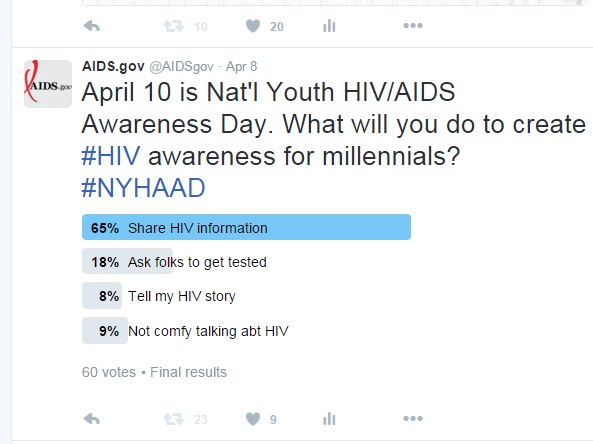Twitter Polls: Same Channel, New Engagement

HIV.gov is always exploring how social media can amplify our engagementExit Disclaimer.
Our unofficial motto is LETS (Learn, Explore, Try, Share) DO THIS! When Twitter Polls were launched in October 2015, we started watching some brandsExit Disclaimer use them.
Before we tried a Twitter Poll, we set three goals: First, we wanted to test the viability of a new feature. Second, we wanted to assess if we could generate engagement in a new way on Twitter in comparison to our usual tweets. And, third, we wanted to share lessons about engagement and and see if this tool would slow our recent decrease was focused around National Youth HIV/AIDS Awareness Day on April 10th. Having set and accomplished clear goals, it’s time to for us to share - and to encourage you to try your own poll!
Why Twitter Polls?
- Private brandsExit Disclaimer and public health agenciesExit Disclaimer are using the polls to increase their reach. Ask your colleagues and stakeholders who follow you on Twitter if they believe polling will help with your reach. (This could be a question for a poll.)
- You can hear directly from your community/audience – and isn’t that what social media is all about?
- They provide an opportunity for you to ask about specific topics (e.g., “Do you know about PrEP?”) or for a consumer opinion (“What do you think of our new testing app?”). Here are some ideas for poll questionsExit Disclaimer.
- They require a low level of effort. It’s simple to create them.
- They’re easy to measure. This was our first poll, and we wanted to be realistic. So we set a modest benchmark of 20 votes and 10 RT’s, which is the usual number of engagement we get on a regular tweet. We exceeded that, getting 60 votes and 23 RT’sExit Disclaimer in 1 day.
We asked how our federal colleagues were using Twitter Polls. Here is what HRSA shared: “HRSAExit Disclaimer has started using polls as a way to engage followers in discussion about specific health issues on which their awareness and action can have a direct impact. Since Twitter is not a platform that actively supports user feedback, we are using polls to further determine follower interest in, and engagement with, HRSA tweets. We are also testing follower willingness to respond to a poll versus sharing or liking a tweet. We want to see if polls can yield follower engagement, above the average for tweets or likes/shares. Our first pollExit Disclaimer ran for 2 days, and yielded 80 votes and 8,000 impressions, which shows promise in gaining higher user engagement in lieu of a like or share.” - Clair Koroma, Public Affairs Specialist, HRSA, Office of Communications
Mechanics of a Twitter Poll:
- You are allowed to ask 1 question per poll, with up to 4 possible responses.
- Voters can only select one of the responses.
- A poll can last anywhere from 5 minutes to 7 days.
Lessons from our Twitter Poll:
- Use hashtags to increase the visibility of your poll. We tied our poll to #NYHAADExit Disclaimer, which may have increased our engagement levels. Adding #twitterpollExit Disclaimer to your question may also help increase visibility if people are searching for polls.
- Voting is private. Neither the poll creator nor other participants can see who has voted or how they voted. While that may not be optimal from the point of view of an organization conducting a poll, I believe the privacy encourages more people to participate.
- You can’t attach an image to your poll. This did limit how we could make the poll visually stand out. Our solution was to pin the tweetExit Disclaimer so that it was visible.
Follow us on TwitterExit Disclaimer, where you can catch our next poll, tweet us your poll ideas, and updated on HIV news.